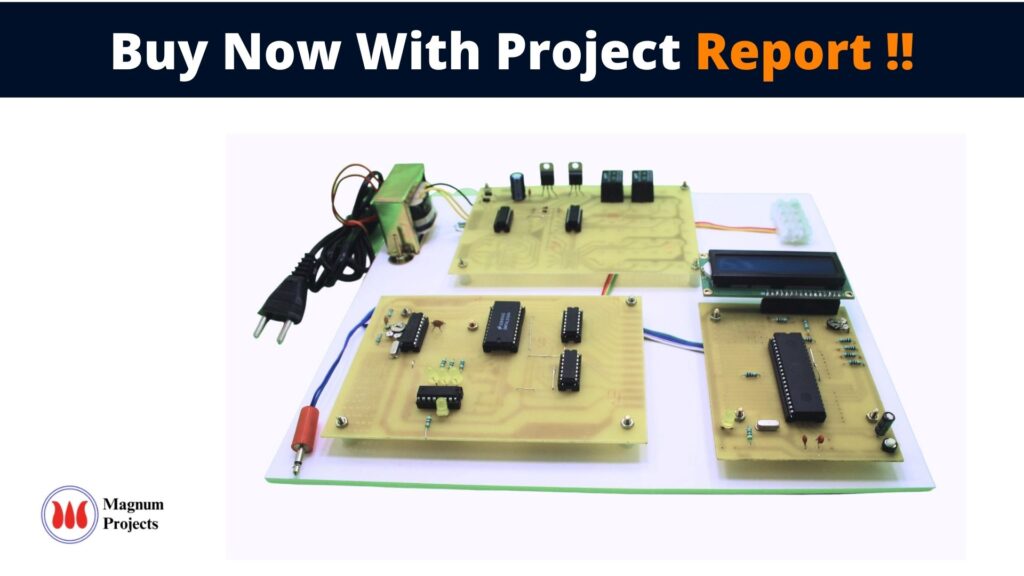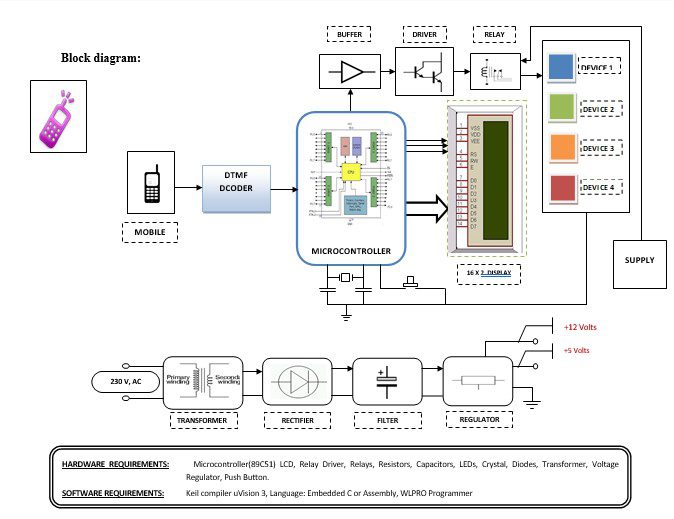Table of Contents
Introduction:


In this era where science and technology are extremely dominant and more prominent, we experience changes in every walk of life. People too respond to these changes very quickly. In their busy schedule, they keep track of only what appears important to them and consciously or willingly forget what they think is the least important. For example, wastage of energy without switching off the devices even after their usage, lack of proper security, etc., By keeping this thought in mind that the ‘least becomes important’, we have designed our project. The systems used so far involve remote control switches using infrared, radio waves, and laser beams. Laser beams are very harmful to mankind. Remote control switches using infrared and radio waves can be used only for short distances. There were also device-switching methods using SMS technology. This paper introduces a system that does not require any harmful radiation and continuous control. Here the devices are switched and controlled by the mobile possessed by the user that makes a call to the mobile which is attached to the system. During a call, when a particular button is pressed, a tone is heard at the other end of the call. This tone is the so-called ‘Dual tone multi-frequency’. The received tone is decoded by using a DTMF decoder. This decoded signal is then sent to a microcontroller for processing. Based on the program loaded in the microcontroller, the corresponding relay is switched with the help of a relay driver. Using this simple, reliable, and flexible system, one can monitor and control home appliances, industrial automated machinery, irrigation purposes on the farm, and security systems employed in banks and other places where high security is required. i.e. control of almost any device.


Block diagram explanation :
Power supply unit:
This section needs two voltages viz., +12 V & +5 V, as working voltages. Hence specially designed power supply is constructed to get regulated power supplies.
Buffers:
Buffers do not affect the logical state of a digital signal (i.e. a logic 1 input results in a logic 1 output whereas logic 0 input results in a logic 0 output). Buffers are normally used to provide extra current drive at the output but can also be used to regularize the logic present at an interface.
Microcontroller:
The 89C51 Microcontroller is the heart of this project. It is the chip that processes the User Data and executes the same. The software inherited in this chip manipulates the data and sends the result for visual display.
The general definition of a microcontroller is a single-chip computer, which refers to the fact that they contain all of the functional sections (cpu, ram, rom, i/o, ports, and timers) of a traditionally defined computer on a single integrated circuit. Some experts even describe them as special-purpose computers with several qualifying distinctions that separate them from other computers.
Features Of Microcontroller :
- 8K Bytes of In-System Reprogrammable Flash Memory
- Endurance: 1,000 Write/Erase Cycles
- Fully Static Operation: 0 Hz to 24 MHz
- Three-level Program Memory Lock
- 256 x 8-bit Internal RAM
- 32 Programmable I/O Lines
- Three 16-bit Timer/Counters
Drivers:
This section is used to drive the relay where the output is the complement of input which is applied to the drive but the current will be amplified.
Relays:
It is an electromagnetic device that is used to drive the load connected across the relay and the o/p of the relay can be connected to the controller or load for further processing.
Indicator:
This stage provides a visual indication of which relay is actuated and deactivated, by glowing respective LED or Buzzer.
DTMF Decoder:
The DTMF decoder used is CM8870. It is used to decode the mobile’s audio signal, i.e., the keypad tone. When the user presses a button on the keypad of the mobile, it generates two tones at the same time. These tones are taken from a table comprising a row frequency and a column frequency. Thus the resulting frequency signal is known as the “Dual Tone Multi-Frequency” signal. A DTMF signal is an algebraic sum of two different frequencies, one from the row frequency (higher frequency) group and another from the low frequency (column frequency) group. The CM8870 decodes the received DTMF tone and then sends its equivalent binary code to the microcontroller. According to the program loaded into the microcontroller, the corresponding action starts.
Methodology:
When we want to turn ON or OFF the devices press the key in the DTMF encoder in encoder which converts digital to analog. The encoded signal is fed to DTMF tone detection and decoding is done by the DTMF decoder, it covers analog to binary form. The binary output of the decoder is fed to the microcontroller, it senses which button is pressed and the corresponding output pin got activated. It acts by utilizing the DTMF signal. The output of the microcontroller given to the relay driver is high, then the corresponding relay can be switched and controlled, thereby the control of devices that are connected to that particular relay can be made possible. These devices can be switched ON and OFF based on the program loaded into the microcontroller by the user.
Advantages:
- The circuit is very useful when you want to operate appliances kept at your home, sitting in your office.
- It can be used in industries for remote operation of devices.
Disadvantages:
If GSM fails to catch the network then failure of controlling the devices.
Applications:
- Automotive.
- Instrumentation.
- Medical electronic.
- Alarm systems.
- Industrial electronics.
- Remote metering




